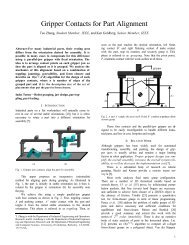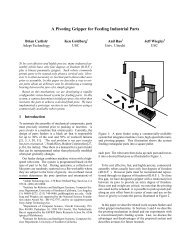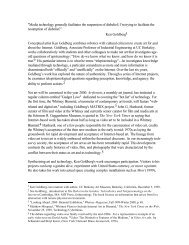“Are We There Yet?” Visual Tracking of Visitors ... - Ken Goldberg
“Are We There Yet?” Visual Tracking of Visitors ... - Ken Goldberg
“Are We There Yet?” Visual Tracking of Visitors ... - Ken Goldberg
You also want an ePaper? Increase the reach of your titles
YUMPU automatically turns print PDFs into web optimized ePapers that Google loves.
<strong>“Are</strong> <strong>We</strong> <strong>There</strong> <strong>Yet</strong>?<strong>”</strong> 15<br />
vector, m 1 n and m 2 n are the x and y coordinates <strong>of</strong> the center <strong>of</strong> the box. m 3 n<br />
and m 4 n are the width and height. To convert the vector back to a subset <strong>of</strong> I,<br />
let m− n = (m1 n − m3n<br />
2 , m2n − m4n<br />
2 ) ∈ I and m+ n = (m1 n + m3n<br />
2 , m2n + m4n<br />
2 ) ∈ I. If<br />
any coordinate lies outside the limits <strong>of</strong> I, we set that coordinate to the closest<br />
value within I, to clip to the image plane. Let νn = {(i, j) : m− n ≤ (i, j) ≤ m + n }.<br />
Finally, ˆ Z(k) = <br />
n< ˆ Z(k) νn ⊂ I, the set <strong>of</strong> pixels within the estimated bounding<br />
boxes.<br />
3.1 Gale-Shapley Matching<br />
Matching observations to tracks makes multiple-target tracking a difficult problem:<br />
in its full generality, the problem requires re-computation <strong>of</strong> the Kalman<br />
filter over the entire time history as previously decided matchings may be rejected<br />
with the additional information, preventing recursive solutions. To avoid<br />
this complexity, sub-optimal solutions are sought. In this section, we describe<br />
a greedy, recursive approach that, for a single frame, matches observations to<br />
tracks to update the Kalman filter bank.<br />
While some algorithms, e.g. mean-shift [10], use information gathered about<br />
the appearance <strong>of</strong> the foreground object to aid in track matching, our algorithm<br />
does not: we assume that individuals are indistinguishable. Here, observationto-track<br />
matching is performed entirely within the context <strong>of</strong> the probability<br />
distribution induced by the Kalman filters. <strong>We</strong> make use <strong>of</strong> the Gale-Shapley<br />
matching algorithm [13], the solution to the “stable-marriage<strong>”</strong> problem.<br />
In what follows, we describe the matching problem at time k. Formally, we<br />
are given M, the set <strong>of</strong> detected foreground object bounding boxes, and ˘ Z,<br />
the set <strong>of</strong> predicted states. Let |M| = M and | ˘ Z| = Z. Introduce placeholder<br />
sets M ∅ and Z ∅ such that |M ∅| = Z and |Z ∅| = M. Further, M M ∅ = ∅<br />
and ˘ Z Z ∅ = ∅. These placeholder sets will allow tracks and observations to<br />
be unpaired, implying a continuation <strong>of</strong> a track with a missed observation [33],<br />
or the creation <strong>of</strong> a new track. Define extended sets as M + = M M ∅ and<br />
Z + = ˘ Z Z ∅. Note that |M + | = |Z + |, a prerequisite for applying the Gale-<br />
Shapley algorithm [13]. Let G ≡ |M + |.<br />
<strong>We</strong> now describe the preference relation necessary for the Gale-Shapley algorithm.<br />
Let mi ∈ M and ˘zj ∈ ˘ Z. ˘zj is the predicted state <strong>of</strong> track j. The<br />
Kalman filter estimates an error covariance for the predicted state: Pj ≻ 0. <strong>We</strong><br />
are interested in comparing observations, not states, so the estimated error covariance<br />
<strong>of</strong> the predicted observation, ˘mj = C ˘zj, is CPjC T + R, from the linear<br />
system described at the start <strong>of</strong> Section 3. The Mahalanobis distance between<br />
two observations under this error covariance matrix is<br />
<br />
d(mi, ˘mj) =<br />
(mi − ˘mj) T (CPjC T + R) −1 (mi − ˘mj) (5)<br />
To make a preference relation, we exponentially weight the distance: ωij =<br />
exp(−d(mi, ˘mj)), ωij ∈ (0, 1). As the distance approaches 0, ωij → 1. Making<br />
use <strong>of</strong> Assumption 6, we place constraints on the distance: for some threshold















